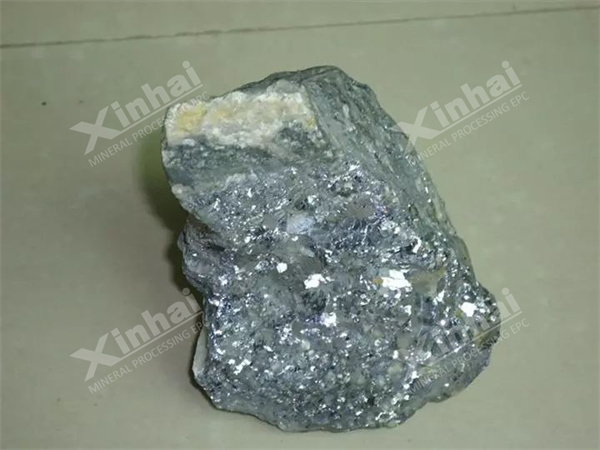The ore dressing process for a polymetallic ore containing silver, copper, lead, and zinc is discussed below.
The representative ore exhibits the following mineralogical composition: oxygen, silicon, calcium, sulfur, copper, zinc, lead, silver, iron, manganese, and trace amounts of carbon, magnesium, sodium, potassium, aluminum, etc. The economically valuable elements are copper, zinc, lead, and silver.
The original ore has a sulfur content of 5.74%. The distribution of copper, lead, zinc, and silver in sulfides is 97.65%, 89.75%, 94.37%, and 86.13%, respectively. The ore has a low oxidation degree, primarily consisting of sulfide minerals.
The main metal minerals in the ore include chalcopyrite, bornite, azurite, sphalerite, galena, silver-bearing bismuth lead ore, chalcopyrite, pyrite, magnetite, hematite, and goethite. There are also small amounts of covellite, stibnite copper ore, and tellurides of silver. The primary gangue minerals are quartz, garnet (mainly andradite), wollastonite, and chlorite, with minor calcite and dolomite.

Industrial Test Flow
The industrial test adopts a copper-lead-zinc sequential flotation process. Figure 1 shows the industrial test principle process flow. The copper selection operation uses a one-time rough selection, three-time scavenging, and two-time cleaning process. The copper collector used is BK901J. The copper tailings enter the lead flotation operation, where the lead process involves a one-time rough selection, three-time scavenging, and four-time cleaning process. The lead tailings then enter a one-time rough selection, three-time scavenging, and three-time cleaning zinc selection process.
The original ore undergoes primary grinding before entering the flotation, with the grinding fineness ranging from 75% to 74 μm. Due to the grid-type ball mill being MQG1500×3000, over-grinding of lead is prone to occur.
Industrial Test Indicators
After a phase of adjustments and improvements, the final process conditions were determined, achieving preliminary test indicators. From August 25th to September 5th, a total of 2800 tons of ore were processed. Deducting downtime due to water interruption or equipment maintenance, the calculated full-load processing capacity was about 270 t/d. The cumulative ore grade was copper 1.75%, lead 5.66%, and zinc 4.64%.
Cumulative indicators were achieved: copper concentrate grade 25.53%, copper recovery rate 67.12%; lead concentrate lead grade 65.24%, lead recovery rate 79.42%; zinc concentrate zinc grade 46.43%, zinc recovery rate 82.60%. Some shifts achieved good indicators with copper, lead, and zinc grades and recovery rates reaching 27.85%, 75.58%, 53.29%, and 84.18%, 81.42%, 86.25%, respectively.
On the basis of the established process flow and operating conditions, production indicators increased month by month from September to December (see Figure 2). In December, the silver recovery rates in copper concentrate and lead concentrate reached 24.72% and 60.84%, respectively. The indicators suggest that the formulated process is suitable.
Issue: Significant fluctuations in ore grade and ore properties.
Measure: Stabilize ore properties and strengthen ore blending.
Issue: Excessive secondary slurry after ore grinding, with varying mud content in different ore types, causing operational instability.
Measure: Strictly control the feed to the ball mill, adjust the proportion of various ball diameters in the ball mill, and adjust operating conditions to stabilize the fineness of the primary grinding to 75%-80% passing 74 μm.
Issue: Presence of impurities like wood chips in the original ore, leading to frequent clogging of the circulation holes in the flotation machine impeller and cover plate.
Measure: Strengthen technical requirements for copper-lead flotation separation, maintaining the concentration of the roughing ore at 35%-36%. Adjust the inhibitor dosage and application points according to the characteristics of the original ore.
Issue: Fluctuations in ore grade affect the flotation time, resulting in poor separation of copper and lead, significant mutual inclusion of products, and low copper recovery rates.
Measure: Address wood chip issues in the flotation slurry by adding isolation devices to the agitating tank.
Issue: Occasionally, the overflow concentration of grinding classification is too high, exceeding 43%, making copper-lead flotation separation difficult.
Measure: Carry out appropriate modifications to the flotation machine.
Issue: Ineffective control of the lime addition system, leading to large variations in lime addition and pH fluctuations in the pulp, affecting flotation efficiency.
Measure: Carry out local modifications to the zinc roughing and cleaning process.
Issue: Occasional interruptions or blockages in some reagents.
Measure: Improve the process reagent system. Adjust the dosage points and amounts of depressants to stabilize the effect of copper-lead separation.
Issue: Inconsistent control of the lime addition system, leading to large variations in lime addition and pH fluctuations in the pulp, affecting flotation efficiency.
Measure: Carry out local modifications to the zinc roughing and cleaning process.
The use of a copper-lead-zinc sequential flotation process for processing silver-copper-lead-zinc polymetallic ores has achieved long-term stable operation in industrial production. In December of the same year, the indicators included copper concentrate with 24.80% copper, 77.0% copper recovery; lead concentrate with 61.28% lead, 75.40% lead recovery; and zinc concentrate with 48.47% zinc, 80.02% zinc recovery. The total recovery rates of silver in copper concentrate and lead concentrate were 85.56%.